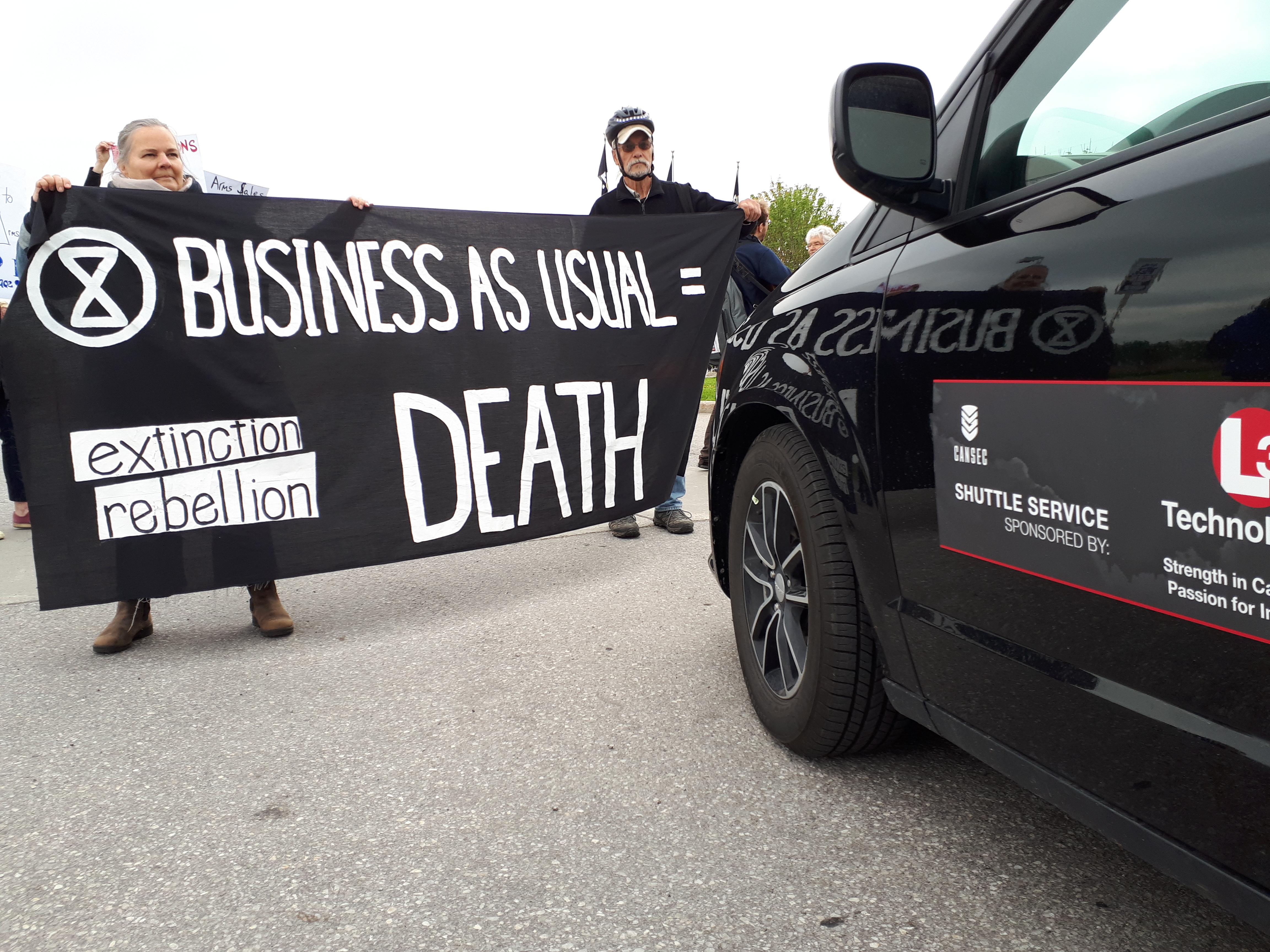CANSEC is the largest arms trade fair in Canada.
It’s where multi-billion-dollar transnational corporations come to promote their products, as CANSEC boasts, to “600 VIPs, Generals, top Military and Government officials” and “40+ delegations from around the world.”
Some of the world’s most profitable weapons merchants attend CANSEC, including Lockheed Martin, whose subsidiary builds the Cyclone twin-engine helicopter for anti-submarine warfare, and Boeing, the maker of the F-18 Super Hornet jet fighter.
In 2015, Lockheed Martin sold $36 billion of arms, turning a profit of $3.6 billion. That same year Boeing sold $28 billion in arms making a profit of $5.2 billion.
On May 29, beginning at 7 a.m. in the morning, close to 100 activists blocked the two entrances at the EY Centre, where CANSEC takes place, not far from Ottawa’s international airport, with the clear message that “Arms dealers are not welcome!”
They succeeded in being highly visible to many of the 11,500 registrants who had to drive or walk past the two-hour-long picket line at the opening of the arms fair.
The picket lines also helped snarl traffic on Uplands Drive and delay the cars, taxis and shuttle buses making their way to hear Canadian Defence Minister Harjit Sajjan’s opening keynote address.
And in an unexpected twist at the start of that morning, a few intrepid activists were able to briefly hold banners near the front-doors of the EY Centre.
The police were not pleased by that and pushed them back up to the sidewalk on Uplands Drive. The explanation from the police? They were just trying to “to keep the peace.” The irony of them saying that outside a war trade fair seemed almost entirely lost on them.
Following that, the police then began “overriding the crosswalk” sign to expedite cars entering the massive parking lot at the EY Centre.
But with some persistence, that soon relented and became a 20-second-on, 20-second-off picket line. That eventually stretched into 100-second blockades.
While not ideal from an activist perspective, it did mean that business people, government officials and soldiers had to sit in their cars and read the multiple banners blocking the roadway.
Prominent among those banners was the Extinction Rebellion “Business As Usual = Death” banner.
Throughout the protest those kinds of links were made between arms sales, war and climate breakdown. In other words, not only does the military drop bombs, it is a carbon bomb.
The Amsterdam-based research group Transnational Institute has highlighted, “The U.S. Department of Defense consumed about 117 million barrels of oil in 2011.”
Furthermore, the Iraq War, which claimed the lives of hundreds of thousands of people, was also responsible for 141 million tonnes of carbon pollution in its first four years.
These are inconvenient truths for those who profit from war.
And for some approaching the peaceful picket line in their expensive business attire and polished luxury cars, even waiting for a couple minutes was too much for them.
Richard Sanders commented in his Facebook post about the protest that, “One guy in a slick Jaguar got quite aggressive about trying to get through our picket line. When he got huffy and agitated he tried using his car as a weapon of sorts.”
He adds, “This prompted one of our folks to make a very particular point about standing his ground, and he stood right in front of the car and refusing to budge out of the way.”
Sanders then shares that the person standing his ground in front of the Jaguar was Ottawa City Councillor Shawn Menard.
This local protest also garnered international attention.
The UK-based War Resisters’ International tweeted, “Activists in Canada have taken action to disrupt the #CANSEC arms fair in Ottawa – solidarity!”
And Stop The Arms Fair!, a network that opposes the world’s biggest arms fair in London, tweeted, “Love and solidarity to these brilliant people saying no to the #CANSEC2019 arms fair!”
Those who blocked traffic for peace, climate justice and an economy based on life not death, have already committed to be present again next year.
That protest will coincide with the #NoWar2020 conference, meaning the numbers on the street could increase by several hundred for next year.
Just prior to this year’s CANSEC, Matthew Behrens reminded us in a Facebook post about a massive protest in 1989 against ARMX, the predecessor of CANSEC.
Behrens wrote, “30 years ago this week, over 200 of us were arrested for blockading the ARMX Weapons Show in Ottawa.” He also highlighted, “Over 3,000 people rallied against the fair the previous weekend.”
Additionally, Behrens recounts that, “A bunch of students from a local high school were walking to school and saw what we were up to. They decided this was more important than taking an algebra exam, and about 25 of them sat down and were arrested!”
It will take that kind of mobilizing, that kind of bringing together of young and old, the strength of multiple movements, and more to finally shut down the atrocity that is CANSEC.
Building on its rich history of past protests, this year’s action was a hopeful springboard to a much larger, even more dynamic and determined protest next year.
For more photos from the CANSEC protest, please click on this link to see Koozma J. Tarasoff’s collection of images from that morning.
Brent Patterson is a political activist and writer.
Image: Brent Patterson
Help make rabble sustainable. Please consider supporting our work with a monthly donation. Support rabble.ca today for as little as $1 per month!




